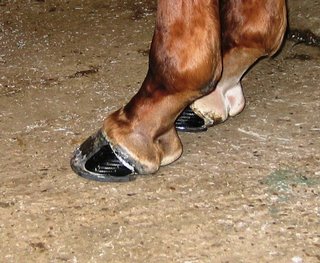 |
| Carbon fiber heel patches developed at the Royal Veterinary College in England are designed to assist the growth of heel quarters. |
It looks like a black potato chip and weighs about the same, but researchers at England's Royal Veterinary College believe that this tiny patch will, when applied correctly, aid horses with underrun heels by redirecting the horn tubule growth from the coronet.
I first heard about the "Heel Support" at the "Maximizing Equine Performance" conference in England this spring. I've been staring at the handful of samples I brought back ever since. Farrier Peter Day at the RVC helped develop the product, and claims that it can stengthen the wall by 40%. Before you scoff, remember that this is the RVC, home of Alan Wilson's Structure and Locomotion Laboratory, where they have any number of ways to test tensile strength of a product or the wall. Wilson's own farrier (and PhD candidate) Chris Pardoe showed me the product.
From a press release about the product: "The prevalence (of collapsed heels) is so high in Thoroughbreds (reportedly affecting between 52% and 97%) that it can lull individuals into thinking that the condition is a normal hoof variation rather than a serious pathological deviation. Despite its prevalence the condition is notoriously difficult to prevent or treat."
Last week I discussed the product with Frank Dugan from Vettec; his company's urethane-based adhesives are used to adhere the patch to the heel below the coronet--placement and adhesion would seem to be key components to success. Frank said that the product's marketing group does not yet have a USA distributor but he was enthusiastic. Since the "chips" are almost weightless, shipping from the UK might not be too expensive.
Marketing is currently through VetCell, the firm that is also marketing the RVC's bone-marrow stem-cell therapy for tendon injuries. The British racehorse Chancellor recently made a victorious comeback to the track wearing the patches; his foot is shown in the photo. No, I can't explain the steel shoes, perhaps they use a thicker training plate in the UK?
If the sea gulls haven't stolen the samples, I will send some to interested farriers or vets to try. Please contact Fran at the Hoofcare Publishing office during business hours: 978 281 3222.
